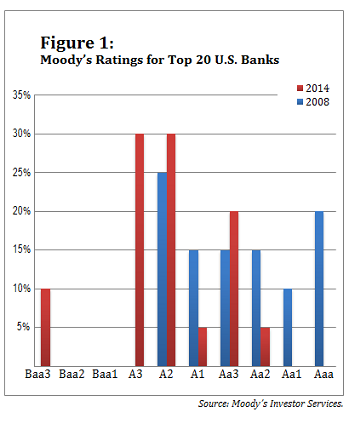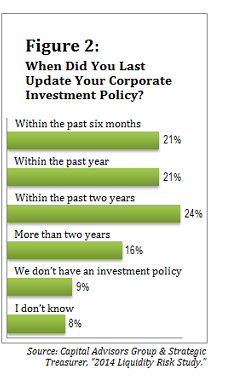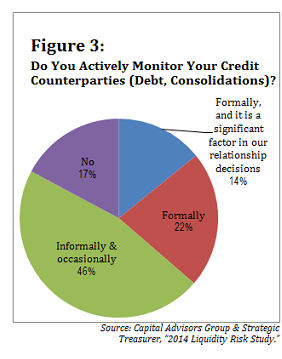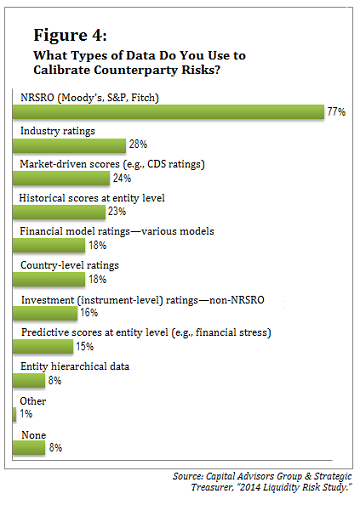 CFOs, treasurers, analysts, and other financial managementdecision-makers have made in-roads in mitigating risk by increasingrestrictions on which banks can hold their uninsured deposits andupdating their investment policies frequently. But despite progressin both understanding and managing counterparty risk, manyorganizations still do not appear to have formal counterparty riskexposure policies or frameworks in place, nor do they appear to beable to adequately aggregate, analyze, and monitor theircounterparty exposures.
CFOs, treasurers, analysts, and other financial managementdecision-makers have made in-roads in mitigating risk by increasingrestrictions on which banks can hold their uninsured deposits andupdating their investment policies frequently. But despite progressin both understanding and managing counterparty risk, manyorganizations still do not appear to have formal counterparty riskexposure policies or frameworks in place, nor do they appear to beable to adequately aggregate, analyze, and monitor theircounterparty exposures.
These were two of the major findings revealed in the fourthannual Liquidity Risk Survey, a study of short-term investment,debt, and forecasting practices conducted by Capital AdvisorsGroup, Inc. and Strategic Treasurer LLC. The 2014 survey, theresults of which were released in May, elicited responses from 112treasury and finance professionals, including CFOs, treasurers,assistant treasurers, vice presidents of finance/treasury, managersor directors of cash investments, treasury/cash managers, andtreasury/cash analysts. Respondents spanned companies ranging insize from over $10 billion in annual revenue (21 percent) to thosewith less than $500 million (29 percent).
||
Progress in Some Areas of RiskMitigation
|Bank ratings have declined significantly since the financialcrisis. In 2008, 60 percent of the top 20 U.S. banks receivedMoody's ratings of Aa3 or better. This year, only 25 percent rankthat high. Similarly, in 2008 Moody's didn't rate any of the topU.S. banks at A3 or below, whereas today 40 percent fall into thatrange. (See Figure 1, below.)
| Perhaps in response, treasury and finance professionalsappear to have continued the practice of paying close attention torisk in their investment portfolio. A half-decade after the peak ofthe financial crisis, survey respondents in 2014 report that theircompany is regularly reviewing and revising its investment policy.Forty-two percent said they have updated their corporate investmentpolicies during the past year—half of those within the six monthsprior to the survey—and two-thirds said they've updated theirpolicies within the past two years (see Figure 2 on page 2).
Perhaps in response, treasury and finance professionalsappear to have continued the practice of paying close attention torisk in their investment portfolio. A half-decade after the peak ofthe financial crisis, survey respondents in 2014 report that theircompany is regularly reviewing and revising its investment policy.Forty-two percent said they have updated their corporate investmentpolicies during the past year—half of those within the six monthsprior to the survey—and two-thirds said they've updated theirpolicies within the past two years (see Figure 2 on page 2).
The content of those policies reflects heightened counterpartyconcerns. One-third of respondents said their company requires aminimum credit rating of AA- or better on uninsured bank deposits,up 9 percentage points (38 percent) in just the past year.Interestingly, the proportion of companies in which investmentpolicies do not specify a minimum counterparty credit rating forbanks holding uninsured deposits—or set a minimum credit rating ofBBB+ or below—also increased 9 percentage points, from 26 percentin 2013 to 35 percent in 2014. This sub-trend bears monitoring infuture surveys.
|| Ongoing concerns about the health of the global bankingand financial system underscore the wisdom of taking measures tomitigate counterparty risks. Companies face exposures from multiplesources, including (but not limited to) bank deposit balances,money market fund holdings, separately managed account holdings,lines of credit, foreign exchange contracts, and vendor andcustomer accounts. Some businesses seem to be implementingstrategies to mitigate risks across counterparties in acomprehensive way. Unfortunately, few organizations appear to haveyet reached that level of sophistication in their risk managementpractices.
Ongoing concerns about the health of the global bankingand financial system underscore the wisdom of taking measures tomitigate counterparty risks. Companies face exposures from multiplesources, including (but not limited to) bank deposit balances,money market fund holdings, separately managed account holdings,lines of credit, foreign exchange contracts, and vendor andcustomer accounts. Some businesses seem to be implementingstrategies to mitigate risks across counterparties in acomprehensive way. Unfortunately, few organizations appear to haveyet reached that level of sophistication in their risk managementpractices.
Major Hurdles Remain
|Counterparty risk management and mitigation appear to continueto pose major challenges for the average corporation's treasury andfinance teams. Results of our 2014 survey indicate that manycompanies lack formal policies for managing counterparty risk, andthey lack techniques for accurately calibrating that risk.
|For one thing, organizations seem to be having difficultycompiling a companywide view of risks. When survey respondents wereasked to identify their company's most urgent need in the realm ofcounterparty risk management, 19 percent selected aggregation ofrisk exposures. Another 18 percent identified knowledge,transparency, and visibility as their most crucial concern.
|Another problem may be that there are critical gaps in manycompanies' processes for formally monitoring counterparty risk. Forexample, only 36 percent of companies surveyed said that theyformally monitor credit counterparties with respect to debt.Moreover, only 14 percent view counterparty risk as a significantfactor in their debt decisions, which represents a sharp contrastto the pervasive implementation and ongoing revision of theirinvestment policies (see Figure 3).
|The techniques companies are using to calibrate counterpartyrisk raise yet another issue: Survey respondents appear to be usinga limited set of variables to calculate the risks they face. Morethan three-quarters of respondents use data from nationallyrecognized statistical ratings organizations (NRSRO) like Moody's,Fitch Ratings, and Standard & Poor's to calibrate counterpartyrisks. Some also use industry ratings and market data, such ascredit default swap (CDS) levels, in assessing counterpartyrisk—but those proportions are much lower (see Figure 4, on page3.). Given the conflict of interest that arises because issuers paythe ratings agencies, using ratings data alone may be insufficientfor gauging risk. It's important to pull together data frommultiple sources and internally generate credit risk ratings.Independent multifactorial models that incorporate qualitative andquantitative variables may provide a clearer and more holistic viewof risk, allowing finance and treasury professionals to moreeffectively limit and manage counterparty risk.
|
A Buyer's Market in Debt
|The survey also revealed ways in which companies are shiftingtheir approach to debt management, likely with the goal ofminimizing their exposure to possible changes in debt markets. Areduction in the number of loan covenants, along with thepossibility that interest rates will increase in the near future,may help to explain why 64 percent of survey respondents said theircompany has negotiated or renegotiated credit facilities in thepast year, up from 56 percent in last year's survey. Twenty-eightpercent of organizations had fewer loan covenants than the lasttime they negotiated debt agreements.
||Additionally, 75 percent of organizations reported that theirdebt has more than one maturity date or that they haveintentionally tried to stagger debt maturity dates, compared withjust 58 percent in 2013. This shift suggests that organizations maybe using multiple maturity dates to guard against unfavorable termsat the time of refinancing or to reduce the impact on theirbusiness if the debt markets freeze up at an inopportune time. Thestrong pace of credit facility negotiation and renegotiation islikely to continue as long as loans have fewer covenants andinterest rates stay low. However, looming interest rate increasesmay impact the current buyer's market for debt by the time weconduct our 2015 survey.
|This year's Liquidity Risk Survey shows a clear trend towardimprovement in certain risk mitigation practices, and we expectthat trend to continue into 2015. Last year, our survey indicated acomplacency toward bank exposures, while this year's surveyrevealed that over the past year companies have taken meaningfulsteps to mitigate risk, including placing limits on uninsured bankdeposits.
|Yet this year's survey suggests that companies remain complacenttoward counterparty risk management. Many practitioners appear tostill lack appropriate frameworks for aggregating, assessing, andmonitoring counterparty risk. They seem to be relying on limiteddata and credit ratings that may not enable them to truly grasprisk trends. We're hopeful that our 2015 survey provides betternews about the adoption and maturation of corporate counterpartyrisk management metrics and tools.
|
——————————————————-
| Benjamin K. Campbell isthe founder and chief executiveofficer of Capital Advisors Group,Inc., which is an independent investmentadvisor specializing in institutional cash investments, credit andcounterparty risk management, and debt financing. He has been namedone of the “100 Most Influential People in Finance” byTreasury & Risk. Email him at [email protected].
Benjamin K. Campbell isthe founder and chief executiveofficer of Capital Advisors Group,Inc., which is an independent investmentadvisor specializing in institutional cash investments, credit andcounterparty risk management, and debt financing. He has been namedone of the “100 Most Influential People in Finance” byTreasury & Risk. Email him at [email protected].
 Craig A. Jeffery is the founderand managing partner of Strategic Treasurer,LLC, which provides corporate, educational,and government entities with direct access tocomprehensive and current assistance with their treasury andfinancial process needs. He is the author of a book fortreasury, “The Strategic Treasurer: A Partnershipfor Corporate Growth.” You can contacthim at [email protected].
Craig A. Jeffery is the founderand managing partner of Strategic Treasurer,LLC, which provides corporate, educational,and government entities with direct access tocomprehensive and current assistance with their treasury andfinancial process needs. He is the author of a book fortreasury, “The Strategic Treasurer: A Partnershipfor Corporate Growth.” You can contacthim at [email protected].
A webinar presenting this survey in full, hosted by BenCampbell and Craig Jeffery, was held on May 6, 2014.An on-demand rebroadcast is available at www.capitaladvisors.com.
Complete your profile to continue reading and get FREE access to Treasury & Risk, part of your ALM digital membership.
Your access to unlimited Treasury & Risk content isn’t changing.
Once you are an ALM digital member, you’ll receive:
- Critical Treasury & Risk information including in-depth analysis of treasury and finance best practices, case studies with corporate innovators, informative newsletters, educational webcasts and videos, and resources from industry leaders.
- Exclusive discounts on ALM and Treasury & Risk events.
- Access to other award-winning ALM websites including PropertyCasualty360.com and Law.com.
*May exclude premium content
Already have an account? Sign In
© 2024 ALM Global, LLC, All Rights Reserved. Request academic re-use from www.copyright.com. All other uses, submit a request to [email protected]. For more information visit Asset & Logo Licensing.







